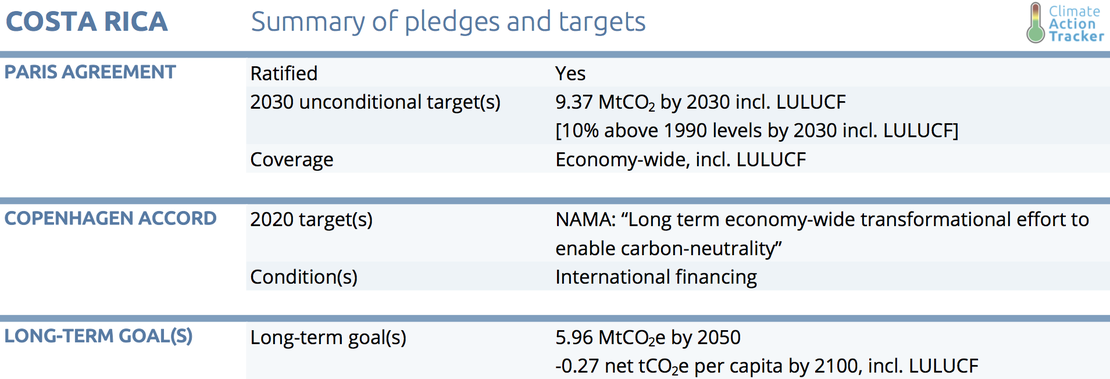Pledges And Targets
Paris Agreement
Costa Rica submitted its NDC with a target of 9.37 MtCO2e emissions in 2030 and an indicative emissions level of 10.9 MtCO2e emissions by 2021 (including LULUCF). The CAT estimates the target to be 13.3 MtCO2e excluding LULUCF for the 2021 projections and 14.5 MtCO2e excluding LULUCF for 2030 target (see “assumptions” section for details on how we derive emissions levels excl. LULUCF). For 2030, this is equivalent to 138% above 1990 levels excluding LULUCF.
The NDC lists mitigation options under four broad categories:
- Reducing energy demand and GHG emissions
- Decarbonisation of energy supply
- Fuel switch for final use
- Management of carbon sinks
2020 pledge
Costa Rica communicated that it will implement a “long-term economy-wide transformational effort to enable carbon-neutrality”, that is, to have zero net emissions including LULUCF (UNFCCC, 2011). It adds that this target will help Costa Rica to significantly deviate from ‘business as usual’ emission scenarios from now until 2021 and beyond. In its previous assessments, the CAT interpreted this target to mean carbon neutrality by 2021, based on the National Climate Change Strategy (ENCC) from 2008 (Ministerio de Ambiente Energia y Telecommunicaciones, 2009).
However, in their NDC (Ministerio de Ambiente y Energía, 2015a) Costa Rica gives a completely different interpretation of their carbon neutrality goal, namely being carbon neutral by 2085, starting in 2021. Indeed, according to the NDC, the definition of carbon neutrality by 2021 is completely redefined and changed to “(achieve) total net emissions comparable to total emissions in 2005”. The reasons for the change in the interpretation of the pledge, which in practical terms means a delay in climate action of 64 years, are unclear. Compared to the pledge, however, the NDC is more precise. The NDC provides exact net emission projections for 2021 (10.9 MtCO2e), Since the NDC—the most recent document—clarifies that the target year for carbon neutrality is 2085, we disregard the previously announced target.
Long-term goals
Costa Rica also has a long-term target aiming at keeping emissions below 5.96 MtCO2e by 2050 including LULUCF (Ministerio de Ambiente y Energía, 2015a). Costa Rica additionally sets per capita emissions targets of 1.73 tCO2e in 2030, 1.19 tCO2e in 2050, and - 0.27 tCO2e in 2100. We do not include the 2050 or 2100 target in our analysis because Costa Rica has only provided LULUCF projections until 2030.

Further analysis
Latest publications
Stay informed
Subscribe to our newsletter




